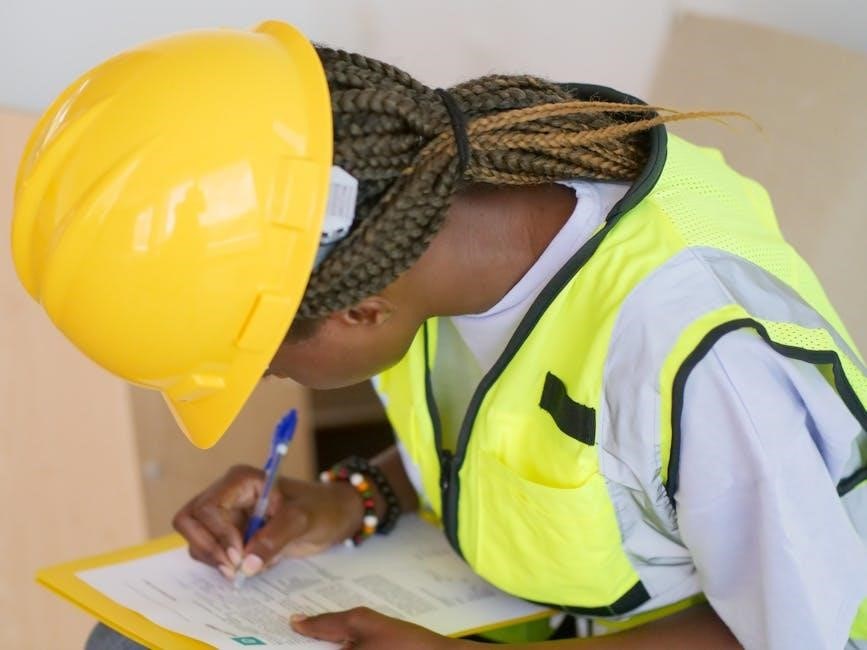safety first grow and go manual pdf

Welcome to the Safety First Grow and Go Manual‚ a comprehensive guide designed to promote safety awareness and best practices for children‚ educators‚ and caregivers․ This manual provides practical strategies to ensure a safe and nurturing environment‚ fostering healthy growth and development․ By following its principles‚ you can create a culture of safety that supports learning‚ play‚ and everyday activities․
Overview of the Manual
The Safety First Grow and Go Manual is a detailed guide that emphasizes the importance of safety in various aspects of daily life‚ growth‚ and development․ It is structured to address diverse environments‚ including home‚ school‚ and outdoor settings‚ providing clear and actionable advice․ The manual covers essential topics such as emergency preparedness‚ personal protective equipment‚ and nutrition safety․ Designed for caregivers‚ educators‚ and parents‚ it offers practical strategies to create a safe and supportive environment for children․ Its comprehensive approach ensures that safety is prioritized at every stage of development‚ fostering a culture of awareness and responsibility․
Importance of Safety in Daily Activities
Safety in daily activities is crucial for preventing injuries‚ fostering confidence‚ and promoting overall well-being․ By integrating safety practices into routines‚ individuals can minimize risks and create a secure environment․ The Safety First Grow and Go Manual highlights how small‚ consistent efforts‚ such as proper hygiene‚ hazard identification‚ and emergency preparedness‚ can significantly reduce accidents․ Prioritizing safety not only protects physical health but also contributes to emotional and cognitive development․ A proactive approach to safety ensures that daily tasks and interactions are conducted with awareness and responsibility‚ laying a strong foundation for a lifetime of safe habits and mindful decision-making․
Target Audience for the Manual
The Safety First Grow and Go Manual is designed for caregivers‚ educators‚ parents‚ and professionals involved in child development․ It serves as a valuable resource for anyone responsible for ensuring the safety and well-being of children․ The manual is particularly beneficial for childcare providers‚ school staff‚ and community educators seeking practical safety strategies․ Its clear guidelines and actionable tips make it accessible to both experienced professionals and new caregivers․ By addressing diverse safety needs‚ the manual supports a wide audience in creating safer environments for children to grow‚ learn‚ and thrive․ Its universal appeal ensures comprehensive safety solutions for all․

Key Features of the Safety First Grow and Go Manual
The manual offers structured guidelines‚ practical tips‚ and visual aids to enhance understanding․ It covers age-specific safety practices and emergency preparedness‚ ensuring a holistic approach to child safety․
Structure and Organization of the Manual
The Safety First Grow and Go Manual is thoughtfully organized into clear sections‚ each addressing specific aspects of safety․ It begins with foundational concepts‚ progresses to practical applications‚ and concludes with advanced strategies․ The manual is divided into chapters‚ each focusing on key areas such as home safety‚ school environments‚ and emergency preparedness․ Visual aids like charts and diagrams complement the text‚ while real-life examples illustrate safety scenarios․ This logical structure ensures ease of navigation‚ making it accessible for parents‚ educators‚ and caregivers to implement safety measures effectively․ The manual’s clear layout enhances understanding and practical application of safety principles․
Practical Tips for Implementing Safety Measures
The manual provides actionable strategies to integrate safety into daily routines․ Start by identifying potential hazards in your environment and creating a safety checklist; Use visual reminders like safety posters and labels to reinforce key messages․ Involve children in safety planning‚ teaching them to recognize risks and take preventive actions․ Conduct regular safety drills‚ such as fire evacuations‚ to build confidence and preparedness․ Encourage open discussions about safety concerns and solutions‚ fostering a proactive mindset․ By applying these tips consistently‚ you can create a safer‚ more aware community․ These practical approaches ensure safety becomes a habit for everyone involved․
Visual Aids and Illustrations for Better Understanding
The manual incorporates engaging visual aids and illustrations to simplify complex safety concepts․ Colorful diagrams‚ infographics‚ and real-life images help users‚ especially children‚ grasp key ideas quickly․ Step-by-step illustrations guide through safety procedures‚ making them easy to follow․ Visual reminders‚ such as safety symbols and charts‚ reinforce important messages․ These visual elements not only enhance comprehension but also make the manual more engaging and accessible for diverse learners; By pairing text with visuals‚ the guide ensures that safety information is both memorable and actionable for everyone․ This approach fosters a deeper understanding of safety practices across all age groups and learning styles․

Safety Principles and Best Practices
The manual outlines foundational safety principles‚ emphasizing prevention‚ awareness‚ and preparedness․ It provides best practices for identifying hazards‚ mitigating risks‚ and fostering a proactive safety culture․
General Safety Guidelines for Everyday Life
The Safety First Grow and Go Manual offers essential guidelines for daily safety‚ ensuring a secure environment for children and adults alike․ It covers fundamental practices such as proper hygiene‚ safe use of household items‚ and awareness of potential hazards․ The manual emphasizes the importance of creating routines that prioritize safety‚ like checking surroundings for risks and teaching children to recognize and avoid danger․ By integrating these practices‚ individuals can reduce accidents and foster a culture of safety in their daily lives‚ promoting overall well-being and confidence․
Emergency Preparedness and Response
The Safety First Grow and Go Manual emphasizes the importance of being prepared for emergencies․ It outlines key steps to create a family emergency plan‚ including identifying escape routes and designating a meeting point․ Regular drills help ensure everyone is ready to act quickly․ The manual also covers basic first aid techniques and fire safety procedures‚ such as using fire extinguishers and evacuating safely․ Additionally‚ it provides guidance on preparing for natural disasters‚ like earthquakes or floods‚ ensuring families are equipped to handle unexpected events confidently and effectively‚ minimizing risks and promoting a swift recovery․ Preparedness is crucial for safety and well-being;
Importance of Personal Protective Equipment (PPE)
Personal Protective Equipment (PPE) plays a vital role in safeguarding individuals from potential hazards․ The Safety First Grow and Go Manual highlights the necessity of using PPE in various scenarios‚ such as sports‚ outdoor activities‚ and handling materials․ Helmets‚ gloves‚ and safety glasses are common examples of PPE that prevent injuries and ensure protection․ By incorporating PPE into daily routines‚ individuals can minimize risks and create a safer environment․ The manual emphasizes proper selection‚ fitting‚ and maintenance of PPE to maximize its effectiveness․ This proactive approach fosters a culture of safety and responsibility‚ especially for children and caregivers‚ promoting long-term well-being and confidence․

Growth and Development Safety Considerations

Growth and Development Safety Considerations focuses on ensuring children’s environments support their physical‚ cognitive‚ and social growth safely․ It highlights age-appropriate safety measures to prevent accidents‚ fostering a secure space for exploration and development․ The manual provides guidance on creating a nurturing atmosphere that balances freedom with protection‚ enabling children to thrive while minimizing risks․ This section is crucial for caregivers aiming to promote healthy development through proactive safety practices․
Safety During Physical Development Stages
Safety During Physical Development Stages emphasizes the importance of adapting safety measures to match children’s growing abilities․ From infancy to adolescence‚ physical skills evolve rapidly‚ requiring tailored precautions․ Ensure environments are free from hazards like sharp objects or hot surfaces․ Supervise activities to prevent accidents during exploration․ Use age-appropriate safety gear‚ such as helmets for biking or soft flooring for play areas․ Regularly assess and update safety strategies as children gain independence․ Promoting physical development safely fosters confidence and resilience while minimizing injury risks․ This section provides practical advice for caregivers to support active growth effectively․
Cognitive Development and Safety Awareness
Cognitive Development and Safety Awareness focuses on helping children understand and apply safety principles through age-appropriate learning․ As children grow‚ their ability to recognize hazards and make safe decisions improves․ This section provides strategies to enhance cognitive skills‚ such as problem-solving and cause-and-effect understanding‚ which are crucial for safety awareness․ Interactive activities and clear communication help children grasp safety concepts․ Teaching safety rules in alignment with developmental milestones ensures they are both effective and engaging․ Encouraging critical thinking fosters a proactive approach to staying safe‚ empowering children to navigate their environments confidently and responsibly․
Social Development and Safety in Interactions
Social Development and Safety in Interactions emphasizes the role of social skills in maintaining safety during daily interactions․ As children develop emotionally and socially‚ they learn to navigate relationships and communicate effectively․ This section explores how fostering empathy‚ cooperation‚ and respect helps children recognize and avoid unsafe social situations․ By teaching boundaries‚ conflict resolution‚ and active listening‚ adults can guide children in building positive interactions․ These skills not only enhance safety but also promote a supportive and inclusive environment‚ encouraging children to thrive socially and emotionally while staying safe in their interactions with others․

Safety Practices for Different Environments
Safety Practices for Different Environments focuses on adapting safety strategies to various settings‚ such as homes‚ schools‚ and outdoor spaces‚ ensuring tailored precautions for each unique environment․
Home Safety Tips and Precautions
Home Safety Tips and Precautions are essential for creating a secure environment․ Ensure furniture and appliances are stable to prevent tipping․ Install safety gates at stairs and secure heavy objects․ Keep hazardous materials like cleaning supplies and medications out of reach․ Regularly check electrical outlets and cords for damage․ Store sharp objects and tools safely․ Ensure windows and doors are locked‚ and consider installing window guards․ Conduct regular safety audits to identify potential risks․ Teach children about emergency exits and practice evacuation drills․ Maintaining a clutter-free space also reduces tripping hazards‚ promoting a safer home for everyone․
School and Playground Safety Measures
School and Playground Safety Measures are crucial for protecting children in educational environments․ Ensure proper supervision during activities and recess․ Regularly inspect playground equipment for damage or wear․ Soft surfaces like rubber mulch or sand should be maintained under play structures to reduce injury risks․ Establish clear rules for behavior‚ such as no pushing or climbing outside designated areas․ Teach children to report hazards or unsafe conditions to adults․ Emergency evacuation plans and fire drills should be practiced regularly․ Ensure first aid kits are accessible‚ and staff are trained in basic first aid and CPR․ Promote open communication between students‚ teachers‚ and parents to address safety concerns promptly․
Outdoor and Community Safety Practices
Outdoor and Community Safety Practices emphasize awareness and preparedness in public spaces․ Teach children to stay alert in crowded areas and avoid talking to strangers․ Ensure they know basic pedestrian rules‚ such as crossing streets at designated areas and following traffic signals․ When visiting parks or playgrounds‚ supervise activities and ensure equipment is safe․ Educate kids about the importance of staying within designated boundaries and avoiding potential hazards like bodies of water or uneven terrain․ Always carry essentials like water‚ snacks‚ and a first-aid kit during outings․ Foster a sense of community by encouraging respect for shared spaces and reporting unsafe conditions to authorities․

Emergency Preparedness and Response

This section covers essential strategies for emergency preparedness and response‚ ensuring safety during crises․ It provides guidance on creating effective plans and staying informed․
First Aid Basics for Common Injuries
Mastering first aid basics is crucial for effectively managing common injuries․ Start with assessing the situation and ensuring safety․ For cuts or scrapes‚ clean the wound with mild soap and water‚ then apply an antibacterial ointment and a bandage․ Burns should be cooled with lukewarm water‚ and the affected area covered loosely․ For fractures or sprains‚ immobilize the injured limb and seek professional medical help promptly․ Remember‚ timely and proper first aid can prevent minor injuries from worsening and promote faster recovery․ Always keep a well-stocked first aid kit handy for emergencies․
Fire Safety and Evacuation Procedures
Fire safety begins with prevention‚ including proper installation and maintenance of smoke detectors․ Conduct regular fire drills to ensure everyone knows escape routes and assembly points․ Teach children to stay low to the ground to avoid smoke inhalation and never to hide in closets or under beds․ During a fire‚ remain calm‚ follow the escape plan‚ and assist others‚ especially those with disabilities․ Once outside‚ gather at a designated meeting spot and call the fire department if not already done․ Never re-enter a burning building; prioritize safety and await professional help․ Familiarity with fire extinguishers is also essential for minor fires․
Natural Disaster Preparedness and Response
Natural disasters like earthquakes‚ floods‚ and hurricanes require proactive planning to ensure safety․ Create an emergency kit with essentials: water‚ non-perishable food‚ first aid supplies‚ flashlights‚ and a battery-powered radio․ Develop a family emergency plan‚ including communication strategies and evacuation routes․ Stay informed about weather alerts and know safe shelters․ Practice drills to prepare children for emergencies․ During a disaster‚ follow evacuation orders promptly and avoid risky areas․ Afterward‚ assess damage cautiously and seek assistance if needed․ Mental health support is crucial for recovery․ Preparation and awareness are key to safeguarding lives and property during natural disasters․

Health and Nutrition Safety
Safety First Grow and Go Manual emphasizes proper food handling‚ hygiene practices‚ and balanced nutrition to prevent foodborne illnesses and promote healthy growth and development in children․
Safe Food Handling and Hygiene Practices
Safe food handling and hygiene practices are essential to prevent foodborne illnesses and promote healthy growth․ Always wash hands thoroughly before handling food․ Separate raw‚ cooked‚ and ready-to-eat foods to avoid cross-contamination․ Cook food to the recommended internal temperature and chill perishables promptly․ Regularly clean and sanitize surfaces‚ utensils‚ and storage areas․ Teach children to avoid eating unwashed fruits or vegetables and to discard expired or spoiled items․ Proper food storage and handling ensure a safe and nutritious environment for children to thrive․
Nutrition and Its Impact on Growth and Development
Nutrition plays a critical role in growth and development‚ influencing physical‚ cognitive‚ and emotional well-being․ A balanced diet rich in essential nutrients supports healthy development․ Provide children with a variety of fruits‚ vegetables‚ whole grains‚ lean proteins‚ and calcium-rich foods․ Limit sugary and processed foods to prevent health issues․ Proper nutrition enhances energy levels‚ concentration‚ and overall growth․ Encourage mindful eating habits and regular hydration to ensure optimal development․ A well-nourished child is better equipped to learn‚ play‚ and thrive in all aspects of life․
Mental Health and Safety Considerations
Mental health is a vital component of overall safety and well-being․ Children need a supportive environment to develop emotional resilience․ Encourage open communication and validate their feelings to foster trust․ Teach coping strategies and stress management techniques to help them navigate challenges․ Monitor for signs of anxiety‚ depression‚ or behavioral changes and seek professional help when needed․ Promote a culture of kindness‚ inclusivity‚ and empathy to ensure their mental safety․ By addressing mental health proactively‚ you create a foundation for their healthy growth and development․

Legal and Ethical Considerations
The Safety First Grow and Go Manual emphasizes compliance with child safety laws‚ ethical practices‚ and responsibilities to ensure a protected environment for growth and development․
Child Safety Laws and Regulations
The Safety First Grow and Go Manual adheres to child safety laws and regulations‚ ensuring compliance with standards like the Consumer Product Safety Improvement Act (CPSIA) and Americans with Disabilities Act (ADA)․ These laws mandate safe environments‚ equipment‚ and practices to protect children from harm․ The manual emphasizes the importance of understanding and implementing these regulations to avoid legal consequences and ethical violations․ By following these guidelines‚ caregivers and educators can create a secure and inclusive setting that promotes healthy growth and development while meeting legal and ethical responsibilities․ Staying informed about updates to these laws is crucial for ongoing compliance․
Ethical Practices in Safety Education
Ethical practices in safety education are fundamental to creating a trustworthy and responsible learning environment․ The Safety First Grow and Go Manual emphasizes honesty‚ transparency‚ and inclusivity in teaching safety principles․ It encourages educators to respect diverse backgrounds and abilities‚ ensuring all children feel safe and supported․ Ethical considerations include avoiding biases‚ promoting empathy‚ and prioritizing children’s well-being․ By integrating these values‚ the manual helps educators model ethical behavior‚ fostering a culture of respect and accountability․ This approach ensures safety education is not only effective but also morally grounded‚ preparing children for a lifelong commitment to safety and ethical decision-making․
Liability and Responsibility in Safety Measures
Understanding liability and responsibility is crucial in implementing safety measures effectively․ The Safety First Grow and Go Manual outlines clear guidelines to help educators and caregivers minimize risks and ensure accountability․ It emphasizes the importance of proper supervision‚ adherence to safety protocols‚ and maintaining appropriate documentation․ By following the manual’s recommendations‚ individuals can reduce potential legal liabilities while creating a secure environment for children․ The manual also stresses the shared responsibility among stakeholders‚ ensuring collective efforts to uphold safety standards and protect everyone involved․ This proactive approach fosters a culture of accountability and mutual respect‚ safeguarding both children and caregivers․
Summarizing Key Safety Concepts
The Safety First Grow and Go Manual emphasizes proactive safety measures across various environments․ It highlights the importance of awareness‚ preparation‚ and education to prevent accidents and injuries․ Key concepts include creating safe spaces at home‚ school‚ and outdoors‚ promoting cognitive development through safety awareness‚ and fostering social interactions with trust and respect․ Practical tips‚ visual aids‚ and emergency preparedness strategies are central to its approach․ By integrating these principles‚ the manual encourages a mindset that prioritizes safety‚ enabling individuals to navigate daily life with confidence and responsibility․ Continuous learning and adaptation are essential for long-term safety and well-being․
Encouraging a Safety-First Mindset
Cultivating a safety-first mindset is crucial for fostering responsible behavior and reducing risks․ The manual encourages individuals to prioritize safety in every activity‚ from daily routines to emergencies․ By promoting awareness and education‚ it helps develop habits that protect physical‚ emotional‚ and mental well-being․ Encouraging open discussions and role-modeling safe practices can inspire others to adopt a proactive approach․ This mindset not only prevents accidents but also builds resilience and confidence‚ ensuring a safer and more supportive environment for everyone․ Continuous reinforcement of safety principles helps maintain this mindset over time․
Continuous Learning and Improvement in Safety
Continuous learning is essential for staying updated on safety best practices․ The manual emphasizes the importance of ongoing education to adapt to new challenges and technologies․ Regular training sessions‚ workshops‚ and reviews of safety protocols ensure that knowledge stays current․ Encouraging feedback and sharing experiences fosters a culture of improvement․ By staying informed and proactive‚ individuals can address potential risks effectively․ This commitment to lifelong learning ensures that safety remains a priority‚ leading to safer environments and better outcomes for everyone involved․ The manual serves as a valuable resource for this ongoing process․